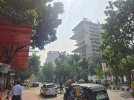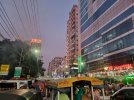How to install the app on iOS
Follow along with the video below to see how to install our site as a web app on your home screen.
Note: This feature may not be available in some browsers.
You are using an out of date browser. It may not display this or other websites correctly.
You should upgrade or use an alternative browser.
You should upgrade or use an alternative browser.
Chill Bangladesh Thread
- Thread starter Arthur
- Start date
Abu Shaleh Rumi
SENIOR MEMBER

- Joined
- Nov 18, 2018
- Messages
- 2,359
- Reaction score
- 0
- Country
- Location
Reza Kibria for PM... 

VikingRaider
SENIOR MEMBER

- Joined
- Aug 2, 2018
- Messages
- 6,713
- Reaction score
- 3
- Country
- Location
Bilal9
ELITE MEMBER

- Joined
- Feb 4, 2014
- Messages
- 26,569
- Reaction score
- 9
- Country
- Location
Ekdik dia bank loot kortesey - hazar hazar koti taka goriber haque martesey, abar firiya goribder hoque gorib-kei khawaitesey.
Shob AL shalar Robin Hood shajar porikolpona.....
Ki buddhi re baba !
PoondolotoPandalum
FULL MEMBER

- Joined
- Jun 24, 2021
- Messages
- 260
- Reaction score
- 1
- Country
- Location
Visited Bangladesh after 14+ years!
Went alone this time, so I dictated my own itinerary. So I didn't have to go Sylhet (town) to visit my maternal grandparents (I'm half Sylheti from my mum's side, and my last grandparent lives in NYC now), where I'm always bored out of my mind xD. Even my maternal grandparents thought so. Which is why they spent most of their time in Chittagong and Dhaka, hah!
I flew there on a Biman 787-8 (Manchester to Sylhet, then Sylhet to Dhaka). Incidentally it was the EXACT same plane I saw at Farnborough Airshow in 2018, when Boeing presented their 787 in Biman colors at the very first time! The service was pretty good and flawless in my experience. The passengers were a mixed bag. Mostly okay, though I sometimes wished Fazle Hasan Abed did more work in the Bengali Ghettos of East London and Oldham, to bring down their 1970s Moulvibazaar levels of fertility rate. But overall, I've seen more eventful flights on other airliners (and not the good kind of eventful). Most of the passengers got off at Sylhet. Few local Bangladeshi's boarded my flight to Dhaka, mostly tourists from Dhaka.
First impression before touching down on Dhaka was; OMG!! just look at the sheer density of buildings! It's unlike any place on earth. It's noticeably much more built up than before. There's hardly any space left available. Dhaka Shahjalal airport is pretty awful, it's worse than many train stations in Bangladesh. It hardly ever changed in my lifetime. It doesn't leave a positive impression on foreigners. Hopefully Terminal 3 can somewhat change this. Dhaka is almost completely slum-free. The folks who used to live in the slums now reside in the older apartments that middle-class folks used to live in the 1990s. Current middle classes live in fairly comfortable apartments that are between 5-10 years old.
I stayed in Dhanmondi. It's a very cosmopolitan part of Dhaka with a lot of eateries. It's close to Shangshad Bhaban and Sheik Mujib's house, so there's lots of security. It's easy to walk around solo without getting mugged. I had enough time to visit the Padma bridge and a rural village next to it (forgot the name). Village life in Bangladesh is a far cry from what they used to be. Far from the hotspots of poverty, illiteracy, villagers tend to live a more comfortable life than city dwellers these days.
Dhaka is an even bigger clusterf*ck than before. But, I still maintain, no place on earth makes you feel as alive as Dhaka. Partially because of how much closer to death it often makes you feel (suicidal traffic) xD But mostly because it has this magical energy, vibe that I can't find anywhere on earth. Going anywhere in Dhaka feels like an event! Just walking solo within streets of Dhaka feels like an adventure. Just soak in the ambiance, full of many many people, each of them with their unique journies and story. They all have this thing missing from a lot of westerners (to my perception). A sense of purpose. It's just so amazingly full of life compared to the grey, miserable, obnoxiously self-centered, and increasingly pessimistic and cynical life of westerners.
Overall, a great adventure, even though I didn't have much time. I'll upload some photos!
Went alone this time, so I dictated my own itinerary. So I didn't have to go Sylhet (town) to visit my maternal grandparents (I'm half Sylheti from my mum's side, and my last grandparent lives in NYC now), where I'm always bored out of my mind xD. Even my maternal grandparents thought so. Which is why they spent most of their time in Chittagong and Dhaka, hah!
I flew there on a Biman 787-8 (Manchester to Sylhet, then Sylhet to Dhaka). Incidentally it was the EXACT same plane I saw at Farnborough Airshow in 2018, when Boeing presented their 787 in Biman colors at the very first time! The service was pretty good and flawless in my experience. The passengers were a mixed bag. Mostly okay, though I sometimes wished Fazle Hasan Abed did more work in the Bengali Ghettos of East London and Oldham, to bring down their 1970s Moulvibazaar levels of fertility rate. But overall, I've seen more eventful flights on other airliners (and not the good kind of eventful). Most of the passengers got off at Sylhet. Few local Bangladeshi's boarded my flight to Dhaka, mostly tourists from Dhaka.
First impression before touching down on Dhaka was; OMG!! just look at the sheer density of buildings! It's unlike any place on earth. It's noticeably much more built up than before. There's hardly any space left available. Dhaka Shahjalal airport is pretty awful, it's worse than many train stations in Bangladesh. It hardly ever changed in my lifetime. It doesn't leave a positive impression on foreigners. Hopefully Terminal 3 can somewhat change this. Dhaka is almost completely slum-free. The folks who used to live in the slums now reside in the older apartments that middle-class folks used to live in the 1990s. Current middle classes live in fairly comfortable apartments that are between 5-10 years old.
I stayed in Dhanmondi. It's a very cosmopolitan part of Dhaka with a lot of eateries. It's close to Shangshad Bhaban and Sheik Mujib's house, so there's lots of security. It's easy to walk around solo without getting mugged. I had enough time to visit the Padma bridge and a rural village next to it (forgot the name). Village life in Bangladesh is a far cry from what they used to be. Far from the hotspots of poverty, illiteracy, villagers tend to live a more comfortable life than city dwellers these days.
Dhaka is an even bigger clusterf*ck than before. But, I still maintain, no place on earth makes you feel as alive as Dhaka. Partially because of how much closer to death it often makes you feel (suicidal traffic) xD But mostly because it has this magical energy, vibe that I can't find anywhere on earth. Going anywhere in Dhaka feels like an event! Just walking solo within streets of Dhaka feels like an adventure. Just soak in the ambiance, full of many many people, each of them with their unique journies and story. They all have this thing missing from a lot of westerners (to my perception). A sense of purpose. It's just so amazingly full of life compared to the grey, miserable, obnoxiously self-centered, and increasingly pessimistic and cynical life of westerners.
Overall, a great adventure, even though I didn't have much time. I'll upload some photos!
PoondolotoPandalum
FULL MEMBER

- Joined
- Jun 24, 2021
- Messages
- 260
- Reaction score
- 1
- Country
- Location
Dhaka University visit. It's a special place in my family as it taught so many of my family members (from both sides!). Including my fiance hehe.
I like visiting universities around the world (NTU and NUS in Singapore are the best, by far), so I was really keen on visiting Bangladeshi ones.
Contrary to popular belief of DU being some Chetonna Tatooine full of pseudo-intellectuals (though they're certainly present, like in every university around the world), DU is incredibly diverse culturally.
Getting a place in a public University like DU, Dhaka Medical College, BUET, etc, is no trivial feat. They have limited spaces, relative to the sheer number of candidates in a country of 165 million. Only the absolute creme-de-la-creme gets accepted. The competition, therefore, is unrelenting. These institutions are poorly run (corruption, inefficient bureaucracy, political involvement). But I respect the students who end up studying there given how much of their youth they had to sacrifice to get a chance there. You should have a look at their entrance exams! They're fiendish!
For these reasons, public universities, DU, in particular, tend to mostly attract the poorer demographics, who otherwise could not afford to send their children to private universities. This is why it's so diverse because the backgrounds of the student (the creme-de-la-creme of Bangladesh) are incredibly diverse. And you certainly feel it walking through the campus. You have sons/daughters of literal rickshaw pullers, and those of rich industrialists from Gulshan Banani sharing the same classes. One life in squalid, Chatra league-infested student dormitories on a shoestring budget. They can't even eat properly throughout the day. While the other gets chauffeured right into his class on a Benz.
This creates somewhat of a cultural clash. The village folks in particular often feel the need to constantly prove themselves to metropolitan folks. It's one (but not only) of the reason why DU students gained a reputation for big-headed pompousness! In reality, it's very diverse culturally.
Private Universities, especially the better ones (NSU, BRAC University) are a different kettle of fish. They tend to look down on public universities (DU, and BUET in particular) as institutions for the sons/daughters of rickshaw pullers. If you ask me, they have the most obnoxious student populace in Bangladesh. NSU and BRAC aren't easy to get into either. But the parents have to fork out an enormous lump of money regardless (though few token spaces are left for those from unprivileged backgrounds). Everyone thinks they belong in the Bullingdon Club or something. It's so cringing!
Another unscientific observation made was the fact that millennial/gen Z population of Bangladesh are a lot taller than before. I'm 178cm. I feel shortish in the UK. Used to feel tall when visiting Bangladesh, but not anymore. The older generation are mostly short. But their childrens aren't.
I like visiting universities around the world (NTU and NUS in Singapore are the best, by far), so I was really keen on visiting Bangladeshi ones.
Contrary to popular belief of DU being some Chetonna Tatooine full of pseudo-intellectuals (though they're certainly present, like in every university around the world), DU is incredibly diverse culturally.
Getting a place in a public University like DU, Dhaka Medical College, BUET, etc, is no trivial feat. They have limited spaces, relative to the sheer number of candidates in a country of 165 million. Only the absolute creme-de-la-creme gets accepted. The competition, therefore, is unrelenting. These institutions are poorly run (corruption, inefficient bureaucracy, political involvement). But I respect the students who end up studying there given how much of their youth they had to sacrifice to get a chance there. You should have a look at their entrance exams! They're fiendish!
For these reasons, public universities, DU, in particular, tend to mostly attract the poorer demographics, who otherwise could not afford to send their children to private universities. This is why it's so diverse because the backgrounds of the student (the creme-de-la-creme of Bangladesh) are incredibly diverse. And you certainly feel it walking through the campus. You have sons/daughters of literal rickshaw pullers, and those of rich industrialists from Gulshan Banani sharing the same classes. One life in squalid, Chatra league-infested student dormitories on a shoestring budget. They can't even eat properly throughout the day. While the other gets chauffeured right into his class on a Benz.
This creates somewhat of a cultural clash. The village folks in particular often feel the need to constantly prove themselves to metropolitan folks. It's one (but not only) of the reason why DU students gained a reputation for big-headed pompousness! In reality, it's very diverse culturally.
Private Universities, especially the better ones (NSU, BRAC University) are a different kettle of fish. They tend to look down on public universities (DU, and BUET in particular) as institutions for the sons/daughters of rickshaw pullers. If you ask me, they have the most obnoxious student populace in Bangladesh. NSU and BRAC aren't easy to get into either. But the parents have to fork out an enormous lump of money regardless (though few token spaces are left for those from unprivileged backgrounds). Everyone thinks they belong in the Bullingdon Club or something. It's so cringing!
Another unscientific observation made was the fact that millennial/gen Z population of Bangladesh are a lot taller than before. I'm 178cm. I feel shortish in the UK. Used to feel tall when visiting Bangladesh, but not anymore. The older generation are mostly short. But their childrens aren't.
Attachments
Last edited:
PoondolotoPandalum
FULL MEMBER

- Joined
- Jun 24, 2021
- Messages
- 260
- Reaction score
- 1
- Country
- Location
Karmitola Golf Club (Bangladesh Army, found in 1956).
They make the best BanguChinese (faux chinese) food in Dhaka!
Make sure you adhere to their dress code to get in. I didn't, but the let me in anyway thanks to my retired Major uncle in law
They make the best BanguChinese (faux chinese) food in Dhaka!
Make sure you adhere to their dress code to get in. I didn't, but the let me in anyway thanks to my retired Major uncle in law

Attachments
PoondolotoPandalum
FULL MEMBER

- Joined
- Jun 24, 2021
- Messages
- 260
- Reaction score
- 1
- Country
- Location
Dhaka MRT, Padma Bridge, village life (near padma), and random photos of Dhaka life
Attachments
-
 20221112_143849.jpg533.5 KB · Views: 42
20221112_143849.jpg533.5 KB · Views: 42 -
 20221111_084341.jpg182.8 KB · Views: 38
20221111_084341.jpg182.8 KB · Views: 38 -
 20221111_093633.jpg448.4 KB · Views: 40
20221111_093633.jpg448.4 KB · Views: 40 -
 20221111_094132.jpg713 KB · Views: 41
20221111_094132.jpg713 KB · Views: 41 -
 20221113_140239.jpg399.1 KB · Views: 38
20221113_140239.jpg399.1 KB · Views: 38 -
 20221110_161013.jpg649.3 KB · Views: 37
20221110_161013.jpg649.3 KB · Views: 37 -
 20221110_153209.jpg494 KB · Views: 39
20221110_153209.jpg494 KB · Views: 39 -
 20221108_171235.jpg309.9 KB · Views: 42
20221108_171235.jpg309.9 KB · Views: 42 -
 20221108_171145.jpg439.5 KB · Views: 35
20221108_171145.jpg439.5 KB · Views: 35 -
 20221108_115534.jpg425.5 KB · Views: 32
20221108_115534.jpg425.5 KB · Views: 32 -
 20221113_114037.jpg909.1 KB · Views: 36
20221113_114037.jpg909.1 KB · Views: 36 -
 20221113_110623.jpg876.7 KB · Views: 54
20221113_110623.jpg876.7 KB · Views: 54 -
 20221113_113402.jpg836.9 KB · Views: 31
20221113_113402.jpg836.9 KB · Views: 31 -
 20221112_173121.jpg475.7 KB · Views: 42
20221112_173121.jpg475.7 KB · Views: 42 -
 20221112_134200.jpg496.5 KB · Views: 37
20221112_134200.jpg496.5 KB · Views: 37 -
 20221112_095455.jpg957.9 KB · Views: 51
20221112_095455.jpg957.9 KB · Views: 51
Bilal9
ELITE MEMBER

- Joined
- Feb 4, 2014
- Messages
- 26,569
- Reaction score
- 9
- Country
- Location
Dhaka MRT, Padma Bridge, village life (near padma), and random photos of Dhaka life
The most ill-planned city on the planet - Thanks to generations of bribery-oriented city planning dept.
They will approve any building plan, even those that do not have foundations.
And forget about code enforcement.
Some Sanghis allege buildings are built with bamboo reinforcements, I have to sadly agree with them mostly.
PoondolotoPandalum
FULL MEMBER

- Joined
- Jun 24, 2021
- Messages
- 260
- Reaction score
- 1
- Country
- Location
Bamboo reinforcement isn't even an urban myth! It happens according to friends/family in the civil engineering trade in BDThe most ill-planned city on the planet - Thanks to generations of bribery-oriented city planning dept.
They will approve any building plan, even those that do not have foundations.
And forget about code enforcement.
Some Sanghis allege buildings are built with bamboo reinforcements, I have to sadly agree with them mostly.
Rajuks are some of the biggest bastards out there.
Bilal9
ELITE MEMBER

- Joined
- Feb 4, 2014
- Messages
- 26,569
- Reaction score
- 9
- Country
- Location
Chinese blankets sell like hotcakes in Bangladesh's markets
By Xinhua
Published: Nov 29, 2022 09:42 AM

Salesmen lay out a Chinese blanket at a market in Dhaka, Bangladesh, on Nov. 23, 2022.(Photo: Xinhua)

Salesmen show a Chinese blanket for customers at a market in Dhaka, Bangladesh, on Nov. 23, 2022.(Photo: Xinhua)

A customer visits a stand selling Chinese blankets at a market in Dhaka, Bangladesh, on Nov. 23, 2022.(Photo: Xinhua)

A man arranges Chinese blankets at a market in Dhaka, Bangladesh, on Nov. 23, 2022. Markets in Dhaka are now busy ahead of the peak winter sales season.(Photo: Xinhua)
Markets in Bangladesh's capital Dhaka are now busy ahead of the peak winter sales season.
Thanks to their affordability and attractive designs, readymade garment stores are now attracting many customers with ample collections of Chinese blankets.
The Chinese blankets, which come in a variety of different shapes, sizes and materials, are appealing to increasing numbers of locals, and are priced between 1,500 taka (around 14 U.S. dollars) to 5,000 taka (around 47 dollars) per blanket.
Dhaka's famous Bongo Bazar, a cluster of shops that make up the huge market, has many stores that are solely selling blankets exclusively from China.
As temperatures have plummeted in recent weeks in the country, sales of blankets and other warm clothes have gained momentum in the market, frequented by all classes of people, particularly the middle income group.
The scenario is no different at relatively cheaper shopping outlets at New Market, one of the busiest markets in the capital, and its adjacent Gausia and Chandi Chalk markets, where merchandise from China can be spotted in store fronts.
Ferdousi Akter Lucky lives in an apartment in the Shantinagar area in Dhaka.
She came to Bongo Bazar to buy an elegant blanket for her baby.
"I bought a thin, Chinese blanket for my baby," said Lucky, adding, "I like the color, size, and the price is quite reasonable."
Md. Azad Hossain is a salesman at a shop in Bongo Bazar and during the winter season he is particularly busy.
"I sell Chinese blankets among other popular Chinese products," Hossain said.
"Chinese blankets are made to last a long time," said the salesman.
He went on to say that people opt for the Chinese blankets, as despite being a little pricey, his customers would rather pay a little extra for the far better quality.
"People know that if they buy a good quality blanket they can use it for 10 to 15 years," said the shopkeeper.
Md. Muktar Hossain is the owner of a shop also selling popular Chinese blankets.
"We sell more and more Chinese blankets each year in this wholesale market, with Chinese blankets outselling other countries' products," he said.
"We buy the blankets from Chinese importers and then sell them wholesale all over Bangladesh," he explained.
Tax and profit margins are linked, the trader said, but this hasn't impacted the popularity of the blankets.
By Xinhua
Published: Nov 29, 2022 09:42 AM

Salesmen lay out a Chinese blanket at a market in Dhaka, Bangladesh, on Nov. 23, 2022.(Photo: Xinhua)

Salesmen show a Chinese blanket for customers at a market in Dhaka, Bangladesh, on Nov. 23, 2022.(Photo: Xinhua)

A customer visits a stand selling Chinese blankets at a market in Dhaka, Bangladesh, on Nov. 23, 2022.(Photo: Xinhua)

A man arranges Chinese blankets at a market in Dhaka, Bangladesh, on Nov. 23, 2022. Markets in Dhaka are now busy ahead of the peak winter sales season.(Photo: Xinhua)
Markets in Bangladesh's capital Dhaka are now busy ahead of the peak winter sales season.
Thanks to their affordability and attractive designs, readymade garment stores are now attracting many customers with ample collections of Chinese blankets.
The Chinese blankets, which come in a variety of different shapes, sizes and materials, are appealing to increasing numbers of locals, and are priced between 1,500 taka (around 14 U.S. dollars) to 5,000 taka (around 47 dollars) per blanket.
Dhaka's famous Bongo Bazar, a cluster of shops that make up the huge market, has many stores that are solely selling blankets exclusively from China.
As temperatures have plummeted in recent weeks in the country, sales of blankets and other warm clothes have gained momentum in the market, frequented by all classes of people, particularly the middle income group.
The scenario is no different at relatively cheaper shopping outlets at New Market, one of the busiest markets in the capital, and its adjacent Gausia and Chandi Chalk markets, where merchandise from China can be spotted in store fronts.
Ferdousi Akter Lucky lives in an apartment in the Shantinagar area in Dhaka.
She came to Bongo Bazar to buy an elegant blanket for her baby.
"I bought a thin, Chinese blanket for my baby," said Lucky, adding, "I like the color, size, and the price is quite reasonable."
Md. Azad Hossain is a salesman at a shop in Bongo Bazar and during the winter season he is particularly busy.
"I sell Chinese blankets among other popular Chinese products," Hossain said.
"Chinese blankets are made to last a long time," said the salesman.
He went on to say that people opt for the Chinese blankets, as despite being a little pricey, his customers would rather pay a little extra for the far better quality.
"People know that if they buy a good quality blanket they can use it for 10 to 15 years," said the shopkeeper.
Md. Muktar Hossain is the owner of a shop also selling popular Chinese blankets.
"We sell more and more Chinese blankets each year in this wholesale market, with Chinese blankets outselling other countries' products," he said.
"We buy the blankets from Chinese importers and then sell them wholesale all over Bangladesh," he explained.
Tax and profit margins are linked, the trader said, but this hasn't impacted the popularity of the blankets.
Bilal9
ELITE MEMBER

- Joined
- Feb 4, 2014
- Messages
- 26,569
- Reaction score
- 9
- Country
- Location
Look at how Adani is minting money from Bangladesh via Hasina. Looting of Bangladesh by Modi's business friends continue.

The above link is behind a paywall - if someone has access - then please post the story here.
"Bangladesh would buy Adani’s electricity at more than five times the market price of bulk electricity in the country... Bangladesh must pay Adani roughly $450 million a year in capacity and maintenance charges regardless of whether it generates any electricity — a steep price by industry standards"
The above link is behind a paywall - if someone has access - then please post the story here.
leonblack08
SENIOR MEMBER

- Joined
- Dec 9, 2008
- Messages
- 4,072
- Reaction score
- 0
- Country
- Location
Look at how Adani is minting money from Bangladesh via Hasina. Looting of Bangladesh by Modi's business friends continue.
"Bangladesh would buy Adani’s electricity at more than five times the market price of bulk electricity in the country... Bangladesh must pay Adani roughly $450 million a year in capacity and maintenance charges regardless of whether it generates any electricity — a steep price by industry standards"

The above link is behind a paywall - if someone has access - then please post the story here.
Here's the full version -
How political will often favors a coal billionaire and his dirty fossil fuel
The tale of Gautam Adani’s giant power plant reveals how political will in India bends in favor of the dirty fuel
By Gerry Shih,
Niha Masih
and
Anant Gupta
December 9, 2022 at 2:00 a.m. EST
The Adani power plant under construction in Godda, in India's Jharkhand state, in August. (Atul Loke/Panos Pictures for The Washington Post)
Listen
Comment
Gift
Share
GODDA, India — For years, nothing could stop the massive coal-fired power plant from rising over paddies and palm groves here in eastern India.
Not objections from local farmers, environmental impact review boards, even state officials. Not pledges by India’s leaders to shift toward renewable energy.
Not the fact that the project, ultimately, will benefit few Indians. When the plant comes online, now scheduled for next week, all of the electricity it generates is due to be sold at a premium to neighboring Bangladesh, a heavily indebted country that has excess power capacity and doesn’t need more, documents show.
The project, however, will benefit its builder, Gautam Adani, an Indian billionaire who according to Global Energy Monitor is the largest private developer of coal power plants and coal mines in the world. When his companies’ stock peaked in September, the Bloomberg Billionaires Index ranked Adani as the second-richest person on the planet, behind Elon Musk.
For decades, Indian officials have rebuffed Western pleas to phase out coal, a reliable but dirty energy source that produces one-fifth of all planet-warming carbon emissions. India’s fast-developing economy — it is the world’s second-largest consumer of coal and third-largest carbon emitter — must burn coal for several more decades out of necessity, not choice, they say.
“Critics would have us instantly get rid of all fossil fuel sources that India needs to serve a large population,” Adani, 60, told a conference in Singapore in September. “This would not work for India.”
But the story of Adani’s power plant in Godda offers a stark example of how political will in India often bends in favor of the dirty fuel — and the business titan who dominates the country’s coal industry.
More than two dozen interviews with current and former Indian officials, former Adani Group employees, industry executives and experts, and a review of hundreds of pages of company and government documents, including a confidential power purchase agreement, reveal how Indian officials repeatedly facilitated a project that seemed to make little economic sense.
They also illustrate the remarkable influence of a self-made billionaire whose ascent was closely tied to the rise of Narendra Modi, India’s prime minister. In 2015, Modi laid the groundwork for the Godda plant during a state visit to Bangladesh. It was part of a larger pattern.
After a senior Indian official opposed supplying coal at a discount to tycoons, including Adani, he was removed from his job by the Modi administration. When a local lawmaker led a hunger strike to protest the power station, he was jailed for six months.
On at least three occasions, according to officials and documents, the government revised laws to help Adani’s coal-related businesses and save him at least $1 billion. That came even as Modi told the United Nations he would tax coal and ramp up renewable energy.
In response to a detailed list of questions, a spokesman for the Adani Group did not address the Godda plant or Adani’s relationship with Modi but said the company plans to invest heavily in renewable energy and gradually shift away from coal. Modi’s office did not respond to repeated requests for comment. Indian officials have said that they are making an earnest attempt to roll out renewable energy, and that they hope to meet half of India’s electricity needs from those sources by 2030 and aim to reach net-zero emissions by 2070.
Today, the Adani Group owns eight airports and 13 seaports. It has rapidly diversified into the media, defense and cement sectors and even become one of India’s leading renewable energy suppliers. Adani’s net worth skyrocketed from $9 billion in 2020 to $127 billion this month.
Still, more than 60 percent of the Adani Group’s revenue is derived from coal-related businesses, according to his seven publicly traded companies’ quarterly reports and industry experts. Those businesses include four coal power plants, 18 coal mines and a coal-trading operation responsible for a quarter of imports into India, which relies on coal for 75 percent of its power generation.
Even within a portfolio so vast, few assets speak to Adani’s influence like the two cooling towers and a smokestack that loom over the Godda countryside.
One recent morning, after monsoon rains had washed away the dust and heat, a bricklayer named Bachchan Yadav recalled the day Adani representatives first showed up at the local crossing.
That was before villagers found out about the project and rallied against it, before hundreds of police officers charged at protesters with batons and jailed their leader, before Chinese engineers arrived by the busload and a hulking plant replaced what used to be fields of rice and chickpeas.
The villagers were naive then, the bricklayer said. They didn’t know whom or what they were up against.
“Bada aadmi, badi baat,” he sighed.
A big man, a big deal.
‘Absolute gouge’
In June 2015, Modi swept into Dhaka for his first trip to Bangladesh, a friendly neighbor with deep cultural and trade ties to India. Modi’s two-day visit was productive: He led prayers at the Hindu Dhakeshwari Temple, settled a 40-year-long border dispute and inked a $4.5 billion deal for India’s state-owned and private companies to sell electricity to Bangladesh.One of the power projects would be built by Adani, who had provided a corporate jet for Modi to use during his political campaign and accompanied the newly elected prime minister on his first visits to Canada and France. After Modi’s trip to Bangladesh, that country’s power authority contracted with Adani to build a $1.7 billion, 1,600-megawatt coal power plant. It would be situated 60 miles from the border, in a village in Godda district.
At the time, the project was seen as a win-win.
For Modi, it was an opportunity to bolster his “Neighborhood First” foreign policy and promote Indian business. Modi asked Bangladesh’s prime minister, Sheikh Hasina, to “facilitate the entry of Indian companies in the power generation, transmission and distribution sector of Bangladesh,” according to an Indian Foreign Ministry readout of their meeting.
Story continues below advertisement
For her part, Hasina envisioned lifting her country into middle-income status by 2020. Electricity demand from Bangladesh’s humming garment factories and booming cities would triple by 2030, the government estimated.
But the confidential 163-page power purchase agreement obtained by The Washington Post, and reviewed by three industry analysts at The Post’s request, suggests the 25-year Godda deal is hardly favorable for Bangladesh.
After the plant comes online, Bangladesh must pay Adani roughly $450 million a year in capacity and maintenance charges regardless of whether it generates any electricity — a steep price by industry standards, according to Tim Buckley, a Sydney-based energy finance analyst. It’s not clear when Bangladesh will actually receive power, because it has not finished its portion of the transmission line. And the plant may not even be needed: Bangladesh now has 40 percent more power generation capacity than peak demand, according to government figures, thanks to years of investment in coal- and gas-fired power stations.
Then there is the cost of coal, which has tripled since war erupted in Ukraine in late February. Other agreements with foreign power suppliers, also seen by The Post, include clauses that would put a cap on the prices Bangladesh pays if the cost of coal skyrockets, but the Godda agreement stipulates that Bangladesh will pay the market price.
And the coal for Godda will probably be supplied by Adani’s own empire. The project’s environmental paperwork shows that 7 million tons a year will be transported from overseas. Industry analysts say the coal will probably come on Adani ships to an Adani-owned port in eastern India, then arrive at the plant on a stretch of Adani-built rail. The electricity generated will be sent to the border over an Adani-built high-voltage line. Under the contract, shipping and transmission costs will be passed on to Bangladesh.
All told, Bangladesh would buy Adani’s electricity at more than five times the market price of bulk electricity in the country, according to Buckley, a longtime energy analyst at major financial firms who focuses, in part, on South Asian markets. Even with coal prices returning to prewar levels, he said, Adani’s power would cost Bangladesh 33 percent more per kilowatt-hour than the publicly disclosed cost of running Bangladesh’s domestic coal-fired plant.
When compared with that of Bangladesh’s Kaptai solar farm, Adani’s power could be five times as expensive.
“It’s an absolute gouge,” Buckley said.
Story continues below advertisement
Hasan Mehedi, a Bangladeshi environmental campaigner who tracks the power industry, said 60 percent of his country’s power plants sit idle on a typical day. He added that the Godda plant will further tie Bangladesh’s future to coal.
“It kicks out space for solar, which is cheaper,” Mehedi said. “But poor communities in one of the hot spots in the global climate crisis will pay more for coal power they don’t need.”
Facing a looming power glut, Bangladesh in 2021 canceled 10 out of 18 planned coal power projects. Mohammad Hossain, a senior power official, told reporters that there was “concern globally” about coal and that renewables were cheaper.
But Adani’s project will proceed. B.D. Rahmatullah, a former director general of Bangladesh’s power regulator, who also reviewed the Adani contract, said Hasina cannot afford to anger India, even if the deal appears unfavorable.
“She knows what is bad and what is good,” he said. “But she knows, ‘If I satisfy Adani, Modi will be happy.’ Bangladesh now is not even a state of India. It is below that.”
A spokesman for Hasina and senior Bangladeshi energy officials did not respond to a detailed list of questions and repeated requests seeking comment.
Big ambitions
The shy but resourceful middle son of a textile merchant, Gautam Adani spent his early years as a modestly successful trader, always on the lookout for deals, said two former colleagues. He roamed the western state of Gujarat on a modest Bajaj scooter. He scoured East Asia for sellers of plastic films and pellets.In 1991, the year India began to liberalize its economy, Adani caught his first big break. He was working as a middleman helping the Minnesota food giant Cargill develop salt mines in Mundra in Gujarat when the deal fell through, leaving Adani with 2,000 acres of white, sandy desert and no project.
So he pivoted. Adani built what was lacking in India: a deep-water port.
Within a decade, Mundra would become India’s most efficient port, awash in one of the country’s most-wanted commodities. Three jetties at Mundra were dedicated to receiving coal, and elevated conveyor belts spanning 10 miles would transport coal from vessels to the world’s largest coal-handling terminal.
Story continues below advertisement
The port put Adani at the center of not only logistics, but also energy, in a country where coal consumption more than doubled between 2006 and 2022. As of September, Adani’s businesses accounted for 25 percent of India’s coal imports this year, according to research firm CoalMint.
“He succeeds in the space where no one succeeds — infrastructure,” said Subhash Chandra Garg, a former Indian finance secretary. “His big ambitions always coincided with where the government is focusing.”
Adani’s reach now extends far beyond coal. He is India’s largest seller of consumer packaged goods and operates its largest urban natural gas provider. He has entered cutting-edge sectors, such as drone manufacturing, data centers and hydrogen fuel — a frontier technology in renewable energy — shortly after they were highlighted in government development plans. To many, he is seen almost as an arm of state policy.
“If he falls, oxygen masks will drop down to save him,” said Narayan Hariharan, a former president of corporate affairs at the Adani Group.
Unlike some Indian business magnates whose fortunes rose and fell with changes in government, Adani rose and rose because he has juggled ties with politicians from every party, supporters and rivals alike say. During the 1990s, he came to know the up-and-coming Gujarati politician Narendra Modi, a general secretary of the Bharatiya Janata Party who took over as the state leader in 2001.
Modi and Adani seemed to mesh, said associates of both men, who spoke on the condition of anonymity to describe private interactions.
One was an ambitious politician, known for his austere lifestyle and religious devotion. The other was a low-key, workaholic industrialist who traveled without large retinues and obsessed over cutting costs.
One former Modi adviser, who also worked with Adani, said Adani’s projects genuinely impressed the Gujarat state leader. The adviser recalled Modi’s delight when he flew over the Mundra port and saw Adani’s railroads stretching across the desert.
“No one had seen that scale of development in the private sector, and, in his mind, Adani was always excellent at execution,” the former adviser said.
Story continues below advertisement
In 2007, the Gujarat government sold Adani 140 square miles for a nominal price, according to news reports, and created a special economic zone (SEZ) around Mundra, which slashed taxes on businesses located within it. The BJP said it was trying to foster development.
In 2009, Adani began building a power station inside the Mundra SEZ that would burn imported coal, transported on his railroad from his nearby port. It was part of what his company called “Integrated Coal Management.”
Adani had entered the power-generation business.
In response to extensive questions from The Post, an Adani Group spokesman declined to address the Godda project, the various government actions related to the plant or Adani’s political relationships. The spokesman said the company plans to invest $100 billion in renewable energy in the coming decade and would gradually shift away from coal.
“As Europe has shown, the stark reality is that replacing fossil fuels is not easy,” he said. “While corporates like us work towards making green energy affordable, equal importance must be placed on making a graduated transition away from fossil fuels so that the hopes and aspirations of our people are not abandoned, literally, in the dark.”
Modi’s office did not respond to an extensive list of questions sent by email or return calls seeking comment about the Godda project and his relationship with Adani. Nor has Modi ever directly addressed their relationship in public remarks. When Indian opposition leaders have accused Modi of being too close to corporate leaders, the prime minister and his allies have often argued that successful companies are crucial in advancing the country’s economy. “Every industrialist who creates money in this country creates jobs. They have created jobs. They must be respected,” K.J. Alphons, a member of Parliament and a former tourism minister under Modi, said in comments before Parliament in February.
Concerns overridden
Soon after Adani signed his power deal with Bangladesh in 2015, some Indian officials expressed concern.Godda is in Jharkhand, India’s second-poorest state. For years, state law required that power plants built in Jharkhand sell 25 percent of their generated power back to the state at a discount. But Adani sought an exception for Godda, former officials said; he offered to funnel electricity from his plants in other parts of India to Jharkhand instead — albeit at a higher price.
Jharkhand’s finance and energy officials balked.
A 2016 analysis that was conducted by state energy officials and seen by The Post estimated that Jharkhand would lose as much as $240 million a year — and Adani would save more than $1.1 billion over the project’s lifetime — if it proceeded with Adani’s proposal. Scroll.in, an Indian news outlet, reported that state auditors also were concerned about the arrangement.
As the project stalled, Rajesh Adani — Gautam’s younger brother and the Adani Group’s managing director — flew in for meetings with the Jharkhand chief minister, Raghubar Das, a member of Modi’s BJP. The next morning, Das summoned his aides to the cabinet room at Project House, the leafy Jharkhand government compound built by Soviet engineers, recalled a former state official who was present.
“This must move urgently,” Das instructed his aides, according to the former official, who spoke on the condition of anonymity for fear of retaliation. “Anything that needs to be done, just do it.”
In October 2016, the Jharkhand government amended the 25 percent rule. Adani’s project steamed ahead.
In one memo to the central government, state officials explained that they greenlighted the plant after Adani executives said the project originated from Modi’s state visit and had received “approval in principle” from the highest levels of government.
Story continues below advertisement
While Jharkhand officials wrestled with the project, a parallel process was underway in New Delhi to obtain environmental clearance.
The first environmental review committee to assess Adani’s proposal felt uneasy about the idea of a coal plant that was serving Bangladesh emitting pollution inside India, said C.R. Babu, a Delhi University professor and committee member. For five months, the panel held intense back-and-forth discussions with the company but did not grant approval by the time its term expired and it was disbanded.
After a second committee was formed, in late 2016, then-Environment Minister Anil Dave appeared at its initial gathering to remind the panel of the Modi government’s motto, “Ease of doing business,” recalled a member of the new committee, Sharachchandra Lele, an environmental researcher.
The new committee was inundated by letters from villagers in Godda worrying about pollution and arguing against the project. But Environment Ministry officials pushed back, saying the plant also had local supporters, Lele said.
The panel approved the Godda plant after one sitting.
By early 2018, Adani had received the necessary permits, but there was one more hurdle: potential tax bills on coal worth hundreds of millions of dollars.
That February, the company applied for the creation of an SEZ at the Godda site. The request was striking because the Commerce Ministry in 2016 had specifically prohibited tax-free zones around a single power plant. Citing its regulation, the ministry denied the request.
Months later, the ministry changed its mind. Meeting minutes show officials proposed amending their SEZ regulations and revisited the matter in February 2019 at the direction of then-Commerce Minister Suresh Prabhu, a Modi ally. Officials argued that tax-free zones like the one proposed by Adani would promote energy exports. A month later, Adani got his SEZ.
Calculations by The Post show Adani would save $35 million a year just on his coal imports for Godda. Coal imports are usually taxed at 400 rupees, or about $5, per ton.
This year, The Post filed a request under India’s Right to Information Act to obtain records related to how the Commerce Ministry came to approve the SEZ. After a six-month appeal process, ministry officials told The Post at a hearing that no such records existed.
Prabhu, the former commerce minister, and Das, the former Jharkhand state leader, declined to comment through their personal secretaries. The office of Tanmay Kumar, the Environment Ministry official overseeing power projects, also declined to comment.
Growing influence
In May 2014, fresh off national elections, a triumphant Modi waved from the tarmac in Gujarat, then flew to New Delhi to be sworn in. The Embraer private jet carrying the next prime minister had shuttled Modi throughout the campaign and sported a distinctive purple-and-blue logo on its fuselage: “Adani.”After entering office, India’s new leader declared that improving infrastructure was his “greatest priority” and that abundant electricity, including renewables, would be key. Before the 2015 climate conference in Paris, Modi told the United Nations General Assembly that India would install 175 gigawatts of renewable energy by 2022 and introduce taxes on coal.
Back home, his administration was helping give coal away at bargain prices.
Anil Swarup, Modi’s former coal secretary, said that in 2015, “privileged businessmen” who owned power plants asked the government for discounted coal produced by Coal India, the state mining giant. When he refused, citing ethical concerns, Swarup was summoned by Modi’s secretary and repeatedly asked to give coal away. He still refused, Swarup recounted in an interview, and was soon transferred to the Education Ministry.
Shortly thereafter, Modi’s cabinet revised regulations to allow Coal India to give discounted coal to private buyers. Adani gained the largest share, receiving 10 million tons, or one-third of the stocks, government data showed. After the coal was distributed, the government said in a statement that it was a “win-win” policy that gave private power producers “long term supply security of coal … while consumers will benefit” from lower electricity prices.
Swarup declined to discuss Adani. But as a general matter, Swarup said, “there was a systematic effort by the government to enable certain industrialists.
Adani’s coal portfolio continues to grow. He has 8,760 megawatts’ worth of thermal power projects in the pipeline, including Godda, and has acquired nine new coal mines in the past two years alone. Indian officials, meanwhile, have doubled down on the fossil fuel, saying they plan to add 25 percent more coal-fired power capacity in the coming years.
“Part of the reason the government wants to keep the coal option is because there are very rich people who own coal assets, and they want to wring the last rupee out of those assets,” said Eswaran Somanathan, an economist at the Indian Statistical Institute.
As Adani’s coal business has expanded, so has his ability to overcome scrutiny. In Australia, he defeated a years-long campaign by environmentalists to stop his plans to develop the country’s largest coal mine. Adani’s Carmichael mine, which may provide coal for the Godda plant, began production in December 2021.
In India, tax authorities have struggled to investigate the Adani Group despite suspicions that it overcharged public utilities for electricity by exaggerating the cost of imported coal and machinery. Adani’s attorneys accuse Indian tax authorities of overreaching. The efforts of tax investigators to obtain company records have been blocked in the courts, and the revenue service is fighting Adani in the Supreme Court over whether its probe may proceed.
Adani has similarly turned to the courts to file at least seven defamation suits against journalists. Paranjoy Guha Thakurta and Abir Dasgupta, two journalists who published investigations into Adani’s use of SEZs to reduce his taxes, are under gag orders from a Gujarat court. In July, police arrived at the Delhi home of another reporter, Ravi Nair, and served him with an arrest warrant for alleged defamation.
Nair was not detained, but he called the arrest warrant an attempt at intimidation. Nair, who has published articles about Adani’s coal mines and offshore investors, said company executives have invited him to meet and told him that Adani was “a powerful man.”
“First, they asked me what I wanted,” Nair said. “Then came the threat.”
Unmet promises
When Adani representatives came to Godda in 2015, they, too, opened with friendly offers, villagers said.To move the project forward, the company needed to obtain 1,000 acres of land and local residents’ support. It offered compensation to farmers who owned land and jobs to farm laborers who didn’t. It promised residents new shoes, clothes, schools and latrines.
In an impoverished region where 60 percent of women are illiterate and most residents live in basic homes with thatched roofs, the project seemed promising at first.
Many landowners supported it. But hundreds of other residents, mostly lower-caste laborers who worked the land for subsistence farming, were skeptical. Chintamani Sahu, a retired local schoolteacher, began holding meetings that attracted hundreds of attendees. Meanwhile, Pradeep Yadav, a fiery local legislator, began to speak out against Adani, and local opinion started to turn.
Environmentalists told the crowds the plant would burn 18,000 tons of coal a day and draw 36 million cubic liters of water a year. They spoke of how the 900-foot-tall smokestack would belch pollution as far as eight miles and how that might affect crops and, ultimately, the climate, said Sahu, who can still rattle off the statistics.
When local officials held a hearing in December 2016 on whether the project should move forward, police let in only those carrying yellow invitation letters, residents said. It was unclear who had handed them out, but Sahu and Yadav believe the company was responsible.
Outside the hall, chaos erupted as angry protesters tried to gain entry. Inside, the district administrator asked for a show of hands and determined that 80 percent of the audience supported Adani.
At a second hearing, in March 2017, hundreds of police officers blocked Yadav and his supporters from speaking onstage, leading to a scuffle. Police charged protesters with batons, and fired tear gas and gunshots in the air, according to witnesses and news reports.
“The local officials and police were instruments used by the government,” Yadav said. “If you could build consensus for a project, why would you need to ram it through?”
In April 2017, Yadav and Sahu tried one final tactic: a hunger strike. By day, they marched through Godda chanting, “Adani, go home!” By night, Yadav led a huge crowd in chants hailing the land as a sacred goddess.
Before dawn broke on the seventh day, police swooped in and seized Yadav. He served six months in jail for public disorder, and his movement lost all momentum. Landowners started to sell. Protesters gave up.
“We came home dejected,” said Bachchan Yadav, the bricklayer, who supported Pradeep Yadav after he lost his job at the Adani construction site after two months. “I’d never seen so many police. If even our leader could be arrested, what could we do?”
These days, behind a wall just beyond the last home in the village of Motia, a soaring power plant has materialized. But the schools, toilets, running water, new jobs — much of what Adani promised — have not, residents say.
Company representatives haven’t returned, residents say. Local men, forced to find work elsewhere after the company hired fewer and fewer of them, have gone. Left behind are mostly women and children sustaining themselves on the farmland that remains.
Meena Devi, 40, said her teenage son left this summer in search of work in Delhi after failing to find a job at the Adani plant.
“What else can we do?” Devi asked. “We need to make money to eat.”
In a muddy clearing, villagers gathered around Devi to share their own stories of the battle with Adani. Some said they feared him, others marveled at him. Many confessed they had only a vague sense of a man so influential that he appeared on television and in newspapers only their children could read. When told that he was one of the world’s richest men, a stunned silence fell over the crowd.
So it’s true, Bachchan Yadav murmured.
“People say he can do anything,” the bricklayer said. “And anything, he can get done.”
Meena Devi, a widow from Motia village who lives near the Adani power plant. Her family of sharecroppers has far less land to work on after it was sold to Adani. Her teenage son couldn’t find work at the power plant, so he left home to become a migrant worker. (Atul Loke/Panos Pictures for The Washington Post)
363Comments
Gift Article

By Gerry Shih
Gerry Shih is the India Bureau Chief for the Washington Post, covering India and neighboring countries. Twitter

By Niha Masih
Niha Masih is a reporter at The Washington Post's Seoul hub, where she covers breaking news in the United States and across the world. Previously, she was The Post's India correspondent where she covered the rise of majoritarian nationalism, conflict in Kashmir, the Covid crisis and digital surveillance of citizens. Twitter
Bilal9
ELITE MEMBER

- Joined
- Feb 4, 2014
- Messages
- 26,569
- Reaction score
- 9
- Country
- Location
Here's the full version -
How political will often favors a coal billionaire and his dirty fossil fuel
The tale of Gautam Adani’s giant power plant reveals how political will in India bends in favor of the dirty fuel
By Gerry Shih
,
Niha Masih
and
Anant Gupta
December 9, 2022 at 2:00 a.m. EST
The Adani power plant under construction in Godda, in India's Jharkhand state, in August. (Atul Loke/Panos Pictures for The Washington Post)
Listen
Comment
Gift
Share
GODDA, India — For years, nothing could stop the massive coal-fired power plant from rising over paddies and palm groves here in eastern India.
Not objections from local farmers, environmental impact review boards, even state officials. Not pledges by India’s leaders to shift toward renewable energy.
Not the fact that the project, ultimately, will benefit few Indians. When the plant comes online, now scheduled for next week, all of the electricity it generates is due to be sold at a premium to neighboring Bangladesh, a heavily indebted country that has excess power capacity and doesn’t need more, documents show.
The project, however, will benefit its builder, Gautam Adani, an Indian billionaire who according to Global Energy Monitor is the largest private developer of coal power plants and coal mines in the world. When his companies’ stock peaked in September, the Bloomberg Billionaires Index ranked Adani as the second-richest person on the planet, behind Elon Musk.
For decades, Indian officials have rebuffed Western pleas to phase out coal, a reliable but dirty energy source that produces one-fifth of all planet-warming carbon emissions. India’s fast-developing economy — it is the world’s second-largest consumer of coal and third-largest carbon emitter — must burn coal for several more decades out of necessity, not choice, they say.
“Critics would have us instantly get rid of all fossil fuel sources that India needs to serve a large population,” Adani, 60, told a conference in Singapore in September. “This would not work for India.”
But the story of Adani’s power plant in Godda offers a stark example of how political will in India often bends in favor of the dirty fuel — and the business titan who dominates the country’s coal industry.
More than two dozen interviews with current and former Indian officials, former Adani Group employees, industry executives and experts, and a review of hundreds of pages of company and government documents, including a confidential power purchase agreement, reveal how Indian officials repeatedly facilitated a project that seemed to make little economic sense.
They also illustrate the remarkable influence of a self-made billionaire whose ascent was closely tied to the rise of Narendra Modi, India’s prime minister. In 2015, Modi laid the groundwork for the Godda plant during a state visit to Bangladesh. It was part of a larger pattern.
After a senior Indian official opposed supplying coal at a discount to tycoons, including Adani, he was removed from his job by the Modi administration. When a local lawmaker led a hunger strike to protest the power station, he was jailed for six months.
On at least three occasions, according to officials and documents, the government revised laws to help Adani’s coal-related businesses and save him at least $1 billion. That came even as Modi told the United Nations he would tax coal and ramp up renewable energy.
In response to a detailed list of questions, a spokesman for the Adani Group did not address the Godda plant or Adani’s relationship with Modi but said the company plans to invest heavily in renewable energy and gradually shift away from coal. Modi’s office did not respond to repeated requests for comment. Indian officials have said that they are making an earnest attempt to roll out renewable energy, and that they hope to meet half of India’s electricity needs from those sources by 2030 and aim to reach net-zero emissions by 2070.
Today, the Adani Group owns eight airports and 13 seaports. It has rapidly diversified into the media, defense and cement sectors and even become one of India’s leading renewable energy suppliers. Adani’s net worth skyrocketed from $9 billion in 2020 to $127 billion this month.
Still, more than 60 percent of the Adani Group’s revenue is derived from coal-related businesses, according to his seven publicly traded companies’ quarterly reports and industry experts. Those businesses include four coal power plants, 18 coal mines and a coal-trading operation responsible for a quarter of imports into India, which relies on coal for 75 percent of its power generation.
Even within a portfolio so vast, few assets speak to Adani’s influence like the two cooling towers and a smokestack that loom over the Godda countryside.
One recent morning, after monsoon rains had washed away the dust and heat, a bricklayer named Bachchan Yadav recalled the day Adani representatives first showed up at the local crossing.
That was before villagers found out about the project and rallied against it, before hundreds of police officers charged at protesters with batons and jailed their leader, before Chinese engineers arrived by the busload and a hulking plant replaced what used to be fields of rice and chickpeas.
The villagers were naive then, the bricklayer said. They didn’t know whom or what they were up against.
“Bada aadmi, badi baat,” he sighed.
A big man, a big deal.
‘Absolute gouge’
In June 2015, Modi swept into Dhaka for his first trip to Bangladesh, a friendly neighbor with deep cultural and trade ties to India. Modi’s two-day visit was productive: He led prayers at the Hindu Dhakeshwari Temple, settled a 40-year-long border dispute and inked a $4.5 billion deal for India’s state-owned and private companies to sell electricity to Bangladesh.
One of the power projects would be built by Adani, who had provided a corporate jet for Modi to use during his political campaign and accompanied the newly elected prime minister on his first visits to Canada and France. After Modi’s trip to Bangladesh, that country’s power authority contracted with Adani to build a $1.7 billion, 1,600-megawatt coal power plant. It would be situated 60 miles from the border, in a village in Godda district.
At the time, the project was seen as a win-win.
For Modi, it was an opportunity to bolster his “Neighborhood First” foreign policy and promote Indian business. Modi asked Bangladesh’s prime minister, Sheikh Hasina, to “facilitate the entry of Indian companies in the power generation, transmission and distribution sector of Bangladesh,” according to an Indian Foreign Ministry readout of their meeting.
Story continues below advertisement
For her part, Hasina envisioned lifting her country into middle-income status by 2020. Electricity demand from Bangladesh’s humming garment factories and booming cities would triple by 2030, the government estimated.
But the confidential 163-page power purchase agreement obtained by The Washington Post, and reviewed by three industry analysts at The Post’s request, suggests the 25-year Godda deal is hardly favorable for Bangladesh.
After the plant comes online, Bangladesh must pay Adani roughly $450 million a year in capacity and maintenance charges regardless of whether it generates any electricity — a steep price by industry standards, according to Tim Buckley, a Sydney-based energy finance analyst. It’s not clear when Bangladesh will actually receive power, because it has not finished its portion of the transmission line. And the plant may not even be needed: Bangladesh now has 40 percent more power generation capacity than peak demand, according to government figures, thanks to years of investment in coal- and gas-fired power stations.
Then there is the cost of coal, which has tripled since war erupted in Ukraine in late February. Other agreements with foreign power suppliers, also seen by The Post, include clauses that would put a cap on the prices Bangladesh pays if the cost of coal skyrockets, but the Godda agreement stipulates that Bangladesh will pay the market price.
And the coal for Godda will probably be supplied by Adani’s own empire. The project’s environmental paperwork shows that 7 million tons a year will be transported from overseas. Industry analysts say the coal will probably come on Adani ships to an Adani-owned port in eastern India, then arrive at the plant on a stretch of Adani-built rail. The electricity generated will be sent to the border over an Adani-built high-voltage line. Under the contract, shipping and transmission costs will be passed on to Bangladesh.
All told, Bangladesh would buy Adani’s electricity at more than five times the market price of bulk electricity in the country, according to Buckley, a longtime energy analyst at major financial firms who focuses, in part, on South Asian markets. Even with coal prices returning to prewar levels, he said, Adani’s power would cost Bangladesh 33 percent more per kilowatt-hour than the publicly disclosed cost of running Bangladesh’s domestic coal-fired plant.
When compared with that of Bangladesh’s Kaptai solar farm, Adani’s power could be five times as expensive.
“It’s an absolute gouge,” Buckley said.
Story continues below advertisement
Hasan Mehedi, a Bangladeshi environmental campaigner who tracks the power industry, said 60 percent of his country’s power plants sit idle on a typical day. He added that the Godda plant will further tie Bangladesh’s future to coal.
“It kicks out space for solar, which is cheaper,” Mehedi said. “But poor communities in one of the hot spots in the global climate crisis will pay more for coal power they don’t need.”
Facing a looming power glut, Bangladesh in 2021 canceled 10 out of 18 planned coal power projects. Mohammad Hossain, a senior power official, told reporters that there was “concern globally” about coal and that renewables were cheaper.
But Adani’s project will proceed. B.D. Rahmatullah, a former director general of Bangladesh’s power regulator, who also reviewed the Adani contract, said Hasina cannot afford to anger India, even if the deal appears unfavorable.
“She knows what is bad and what is good,” he said. “But she knows, ‘If I satisfy Adani, Modi will be happy.’ Bangladesh now is not even a state of India. It is below that.”
A spokesman for Hasina and senior Bangladeshi energy officials did not respond to a detailed list of questions and repeated requests seeking comment.
Big ambitions
The shy but resourceful middle son of a textile merchant, Gautam Adani spent his early years as a modestly successful trader, always on the lookout for deals, said two former colleagues. He roamed the western state of Gujarat on a modest Bajaj scooter. He scoured East Asia for sellers of plastic films and pellets.
In 1991, the year India began to liberalize its economy, Adani caught his first big break. He was working as a middleman helping the Minnesota food giant Cargill develop salt mines in Mundra in Gujarat when the deal fell through, leaving Adani with 2,000 acres of white, sandy desert and no project.
So he pivoted. Adani built what was lacking in India: a deep-water port.
Within a decade, Mundra would become India’s most efficient port, awash in one of the country’s most-wanted commodities. Three jetties at Mundra were dedicated to receiving coal, and elevated conveyor belts spanning 10 miles would transport coal from vessels to the world’s largest coal-handling terminal.
Story continues below advertisement
The port put Adani at the center of not only logistics, but also energy, in a country where coal consumption more than doubled between 2006 and 2022. As of September, Adani’s businesses accounted for 25 percent of India’s coal imports this year, according to research firm CoalMint.
“He succeeds in the space where no one succeeds — infrastructure,” said Subhash Chandra Garg, a former Indian finance secretary. “His big ambitions always coincided with where the government is focusing.”
Adani’s reach now extends far beyond coal. He is India’s largest seller of consumer packaged goods and operates its largest urban natural gas provider. He has entered cutting-edge sectors, such as drone manufacturing, data centers and hydrogen fuel — a frontier technology in renewable energy — shortly after they were highlighted in government development plans. To many, he is seen almost as an arm of state policy.
“If he falls, oxygen masks will drop down to save him,” said Narayan Hariharan, a former president of corporate affairs at the Adani Group.
Unlike some Indian business magnates whose fortunes rose and fell with changes in government, Adani rose and rose because he has juggled ties with politicians from every party, supporters and rivals alike say. During the 1990s, he came to know the up-and-coming Gujarati politician Narendra Modi, a general secretary of the Bharatiya Janata Party who took over as the state leader in 2001.
Modi and Adani seemed to mesh, said associates of both men, who spoke on the condition of anonymity to describe private interactions.
One was an ambitious politician, known for his austere lifestyle and religious devotion. The other was a low-key, workaholic industrialist who traveled without large retinues and obsessed over cutting costs.
One former Modi adviser, who also worked with Adani, said Adani’s projects genuinely impressed the Gujarat state leader. The adviser recalled Modi’s delight when he flew over the Mundra port and saw Adani’s railroads stretching across the desert.
“No one had seen that scale of development in the private sector, and, in his mind, Adani was always excellent at execution,” the former adviser said.
Story continues below advertisement
In 2007, the Gujarat government sold Adani 140 square miles for a nominal price, according to news reports, and created a special economic zone (SEZ) around Mundra, which slashed taxes on businesses located within it. The BJP said it was trying to foster development.
In 2009, Adani began building a power station inside the Mundra SEZ that would burn imported coal, transported on his railroad from his nearby port. It was part of what his company called “Integrated Coal Management.”
Adani had entered the power-generation business.
In response to extensive questions from The Post, an Adani Group spokesman declined to address the Godda project, the various government actions related to the plant or Adani’s political relationships. The spokesman said the company plans to invest $100 billion in renewable energy in the coming decade and would gradually shift away from coal.
“As Europe has shown, the stark reality is that replacing fossil fuels is not easy,” he said. “While corporates like us work towards making green energy affordable, equal importance must be placed on making a graduated transition away from fossil fuels so that the hopes and aspirations of our people are not abandoned, literally, in the dark.”
Modi’s office did not respond to an extensive list of questions sent by email or return calls seeking comment about the Godda project and his relationship with Adani. Nor has Modi ever directly addressed their relationship in public remarks. When Indian opposition leaders have accused Modi of being too close to corporate leaders, the prime minister and his allies have often argued that successful companies are crucial in advancing the country’s economy. “Every industrialist who creates money in this country creates jobs. They have created jobs. They must be respected,” K.J. Alphons, a member of Parliament and a former tourism minister under Modi, said in comments before Parliament in February.
Concerns overridden
Soon after Adani signed his power deal with Bangladesh in 2015, some Indian officials expressed concern.
Godda is in Jharkhand, India’s second-poorest state. For years, state law required that power plants built in Jharkhand sell 25 percent of their generated power back to the state at a discount. But Adani sought an exception for Godda, former officials said; he offered to funnel electricity from his plants in other parts of India to Jharkhand instead — albeit at a higher price.
Jharkhand’s finance and energy officials balked.
A 2016 analysis that was conducted by state energy officials and seen by The Post estimated that Jharkhand would lose as much as $240 million a year — and Adani would save more than $1.1 billion over the project’s lifetime — if it proceeded with Adani’s proposal. Scroll.in, an Indian news outlet, reported that state auditors also were concerned about the arrangement.
As the project stalled, Rajesh Adani — Gautam’s younger brother and the Adani Group’s managing director — flew in for meetings with the Jharkhand chief minister, Raghubar Das, a member of Modi’s BJP. The next morning, Das summoned his aides to the cabinet room at Project House, the leafy Jharkhand government compound built by Soviet engineers, recalled a former state official who was present.
“This must move urgently,” Das instructed his aides, according to the former official, who spoke on the condition of anonymity for fear of retaliation. “Anything that needs to be done, just do it.”
In October 2016, the Jharkhand government amended the 25 percent rule. Adani’s project steamed ahead.
In one memo to the central government, state officials explained that they greenlighted the plant after Adani executives said the project originated from Modi’s state visit and had received “approval in principle” from the highest levels of government.
Story continues below advertisement
While Jharkhand officials wrestled with the project, a parallel process was underway in New Delhi to obtain environmental clearance.
The first environmental review committee to assess Adani’s proposal felt uneasy about the idea of a coal plant that was serving Bangladesh emitting pollution inside India, said C.R. Babu, a Delhi University professor and committee member. For five months, the panel held intense back-and-forth discussions with the company but did not grant approval by the time its term expired and it was disbanded.
After a second committee was formed, in late 2016, then-Environment Minister Anil Dave appeared at its initial gathering to remind the panel of the Modi government’s motto, “Ease of doing business,” recalled a member of the new committee, Sharachchandra Lele, an environmental researcher.
The new committee was inundated by letters from villagers in Godda worrying about pollution and arguing against the project. But Environment Ministry officials pushed back, saying the plant also had local supporters, Lele said.
The panel approved the Godda plant after one sitting.
By early 2018, Adani had received the necessary permits, but there was one more hurdle: potential tax bills on coal worth hundreds of millions of dollars.
That February, the company applied for the creation of an SEZ at the Godda site. The request was striking because the Commerce Ministry in 2016 had specifically prohibited tax-free zones around a single power plant. Citing its regulation, the ministry denied the request.
Months later, the ministry changed its mind. Meeting minutes show officials proposed amending their SEZ regulations and revisited the matter in February 2019 at the direction of then-Commerce Minister Suresh Prabhu, a Modi ally. Officials argued that tax-free zones like the one proposed by Adani would promote energy exports. A month later, Adani got his SEZ.
Calculations by The Post show Adani would save $35 million a year just on his coal imports for Godda. Coal imports are usually taxed at 400 rupees, or about $5, per ton.
This year, The Post filed a request under India’s Right to Information Act to obtain records related to how the Commerce Ministry came to approve the SEZ. After a six-month appeal process, ministry officials told The Post at a hearing that no such records existed.
Prabhu, the former commerce minister, and Das, the former Jharkhand state leader, declined to comment through their personal secretaries. The office of Tanmay Kumar, the Environment Ministry official overseeing power projects, also declined to comment.
Growing influence
In May 2014, fresh off national elections, a triumphant Modi waved from the tarmac in Gujarat, then flew to New Delhi to be sworn in. The Embraer private jet carrying the next prime minister had shuttled Modi throughout the campaign and sported a distinctive purple-and-blue logo on its fuselage: “Adani.”
After entering office, India’s new leader declared that improving infrastructure was his “greatest priority” and that abundant electricity, including renewables, would be key. Before the 2015 climate conference in Paris, Modi told the United Nations General Assembly that India would install 175 gigawatts of renewable energy by 2022 and introduce taxes on coal.
Back home, his administration was helping give coal away at bargain prices.
Anil Swarup, Modi’s former coal secretary, said that in 2015, “privileged businessmen” who owned power plants asked the government for discounted coal produced by Coal India, the state mining giant. When he refused, citing ethical concerns, Swarup was summoned by Modi’s secretary and repeatedly asked to give coal away. He still refused, Swarup recounted in an interview, and was soon transferred to the Education Ministry.
Shortly thereafter, Modi’s cabinet revised regulations to allow Coal India to give discounted coal to private buyers. Adani gained the largest share, receiving 10 million tons, or one-third of the stocks, government data showed. After the coal was distributed, the government said in a statement that it was a “win-win” policy that gave private power producers “long term supply security of coal … while consumers will benefit” from lower electricity prices.
Swarup declined to discuss Adani. But as a general matter, Swarup said, “there was a systematic effort by the government to enable certain industrialists.
Adani’s coal portfolio continues to grow. He has 8,760 megawatts’ worth of thermal power projects in the pipeline, including Godda, and has acquired nine new coal mines in the past two years alone. Indian officials, meanwhile, have doubled down on the fossil fuel, saying they plan to add 25 percent more coal-fired power capacity in the coming years.
“Part of the reason the government wants to keep the coal option is because there are very rich people who own coal assets, and they want to wring the last rupee out of those assets,” said Eswaran Somanathan, an economist at the Indian Statistical Institute.
As Adani’s coal business has expanded, so has his ability to overcome scrutiny. In Australia, he defeated a years-long campaign by environmentalists to stop his plans to develop the country’s largest coal mine. Adani’s Carmichael mine, which may provide coal for the Godda plant, began production in December 2021.
In India, tax authorities have struggled to investigate the Adani Group despite suspicions that it overcharged public utilities for electricity by exaggerating the cost of imported coal and machinery. Adani’s attorneys accuse Indian tax authorities of overreaching. The efforts of tax investigators to obtain company records have been blocked in the courts, and the revenue service is fighting Adani in the Supreme Court over whether its probe may proceed.
Adani has similarly turned to the courts to file at least seven defamation suits against journalists. Paranjoy Guha Thakurta and Abir Dasgupta, two journalists who published investigations into Adani’s use of SEZs to reduce his taxes, are under gag orders from a Gujarat court. In July, police arrived at the Delhi home of another reporter, Ravi Nair, and served him with an arrest warrant for alleged defamation.
Nair was not detained, but he called the arrest warrant an attempt at intimidation. Nair, who has published articles about Adani’s coal mines and offshore investors, said company executives have invited him to meet and told him that Adani was “a powerful man.”
“First, they asked me what I wanted,” Nair said. “Then came the threat.”
Unmet promises
When Adani representatives came to Godda in 2015, they, too, opened with friendly offers, villagers said.
To move the project forward, the company needed to obtain 1,000 acres of land and local residents’ support. It offered compensation to farmers who owned land and jobs to farm laborers who didn’t. It promised residents new shoes, clothes, schools and latrines.
In an impoverished region where 60 percent of women are illiterate and most residents live in basic homes with thatched roofs, the project seemed promising at first.
Many landowners supported it. But hundreds of other residents, mostly lower-caste laborers who worked the land for subsistence farming, were skeptical. Chintamani Sahu, a retired local schoolteacher, began holding meetings that attracted hundreds of attendees. Meanwhile, Pradeep Yadav, a fiery local legislator, began to speak out against Adani, and local opinion started to turn.
Environmentalists told the crowds the plant would burn 18,000 tons of coal a day and draw 36 million cubic liters of water a year. They spoke of how the 900-foot-tall smokestack would belch pollution as far as eight miles and how that might affect crops and, ultimately, the climate, said Sahu, who can still rattle off the statistics.
When local officials held a hearing in December 2016 on whether the project should move forward, police let in only those carrying yellow invitation letters, residents said. It was unclear who had handed them out, but Sahu and Yadav believe the company was responsible.
Outside the hall, chaos erupted as angry protesters tried to gain entry. Inside, the district administrator asked for a show of hands and determined that 80 percent of the audience supported Adani.
At a second hearing, in March 2017, hundreds of police officers blocked Yadav and his supporters from speaking onstage, leading to a scuffle. Police charged protesters with batons, and fired tear gas and gunshots in the air, according to witnesses and news reports.
“The local officials and police were instruments used by the government,” Yadav said. “If you could build consensus for a project, why would you need to ram it through?”
In April 2017, Yadav and Sahu tried one final tactic: a hunger strike. By day, they marched through Godda chanting, “Adani, go home!” By night, Yadav led a huge crowd in chants hailing the land as a sacred goddess.
Before dawn broke on the seventh day, police swooped in and seized Yadav. He served six months in jail for public disorder, and his movement lost all momentum. Landowners started to sell. Protesters gave up.
“We came home dejected,” said Bachchan Yadav, the bricklayer, who supported Pradeep Yadav after he lost his job at the Adani construction site after two months. “I’d never seen so many police. If even our leader could be arrested, what could we do?”
These days, behind a wall just beyond the last home in the village of Motia, a soaring power plant has materialized. But the schools, toilets, running water, new jobs — much of what Adani promised — have not, residents say.
Company representatives haven’t returned, residents say. Local men, forced to find work elsewhere after the company hired fewer and fewer of them, have gone. Left behind are mostly women and children sustaining themselves on the farmland that remains.
Meena Devi, 40, said her teenage son left this summer in search of work in Delhi after failing to find a job at the Adani plant.
“What else can we do?” Devi asked. “We need to make money to eat.”
In a muddy clearing, villagers gathered around Devi to share their own stories of the battle with Adani. Some said they feared him, others marveled at him. Many confessed they had only a vague sense of a man so influential that he appeared on television and in newspapers only their children could read. When told that he was one of the world’s richest men, a stunned silence fell over the crowd.
So it’s true, Bachchan Yadav murmured.
“People say he can do anything,” the bricklayer said. “And anything, he can get done.”
Meena Devi, a widow from Motia village who lives near the Adani power plant. Her family of sharecroppers has far less land to work on after it was sold to Adani. Her teenage son couldn’t find work at the power plant, so he left home to become a migrant worker. (Atul Loke/Panos Pictures for The Washington Post)
363Comments
Gift Article

By Gerry Shih
Gerry Shih is the India Bureau Chief for the Washington Post, covering India and neighboring countries. Twitter

By Niha Masih
Niha Masih is a reporter at The Washington Post's Seoul hub, where she covers breaking news in the United States and across the world. Previously, she was The Post's India correspondent where she covered the rise of majoritarian nationalism, conflict in Kashmir, the Covid crisis and digital surveillance of citizens. Twitter
Bhai @leonblack08 I really owe you one. Thanks!
Just goes to show how this govts. functionaries are funneling massive amounts of money to India (and also Modi).
The project to blood-suck Bangladesh dry continues....
Bilal9
ELITE MEMBER

- Joined
- Feb 4, 2014
- Messages
- 26,569
- Reaction score
- 9
- Country
- Location
This story is from four years ago.
The fight for "Little Bangladesh" in LA continues despite Korean territorialism.
We will keep fighting and we will eventually win.
The vice story has a definite Korean slant and shows more of their side of the story.
The fight for "Little Bangladesh" in LA continues despite Korean territorialism.
We will keep fighting and we will eventually win.
The vice story has a definite Korean slant and shows more of their side of the story.
Similar threads
- Replies
- 1
- Views
- 439
- Replies
- 0
- Views
- 979
- Replies
- 1
- Views
- 837





